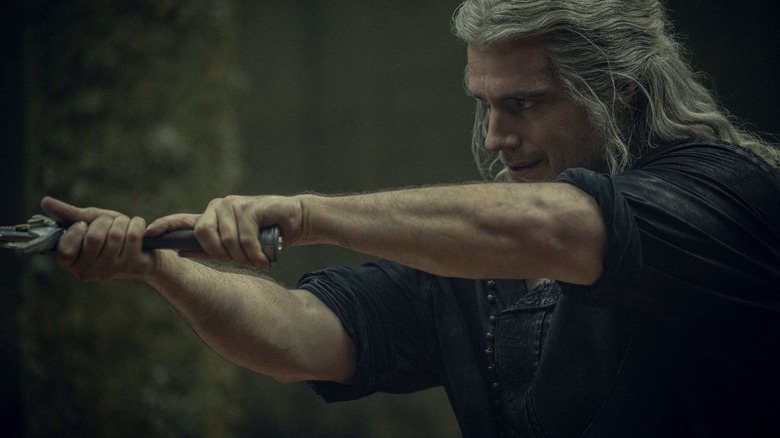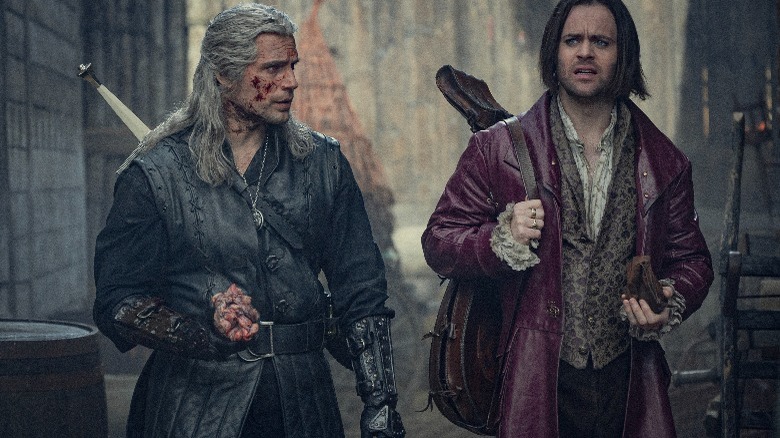Why The Witcher Season 3 Is Broken Into Two Parts
Volume I of Netflix's "The Witcher" premiered at the end of June, and the next installment will make its way to the streaming platform just as July ends. This decision to split a season into two parts already has a successful precedent: "Stranger Things" season 4 managed to tell a gripping story while hugely benefiting from this split module that helped streamline event chronology better.
However, while the two-part season for "Stranger Things" made sense due to the tense nature of the storyline, this decision makes little sense for a show like "The Witcher," which already struggles with juggling too many plot points and doing them justice within the course of an uninterrupted season. Surely there are reasons behind this rising trend where Netflix is experimenting with season formats, and how audiences consume them, evoking a contrast to their long-established (and pretty successful) binge model.
The one-episode-per-week release format is pretty commonplace when it comes to television shows that are mostly franchise-adjacent, key examples being Disney/Lucasfilm's "The Mandalorian" and "Andor," along with Marvel's "Secret Invasion," which has currently reached the halfway mark in its first season. Netflix has abstained from this format for the most part, barring a few examples, including the latest season of "Jujutsu Kaisen," which is set to drop a single episode every week. So, what is the impetus behind Netflix's hybridized model where audiences still get to binge 5 episodes at once but need to wait for a month before the next part of the same season drops? The reasons might range from boosted figures over different quarterly reporting periods to strategic marketing attempts to retain audience viewership. Well, at least in the case of "The Witcher," this is what executive producer Steve Gaub had to say.
The death of cliffhangers
The magic of network television release schedules, or even streaming models where one episode drops every week, lies in the delicious anticipation a well-crafted cliffhanger can induce. Those who've watched the season 1 finale of "Supernatural" (before the advent of the binge model) will relate to the anxiety of seeing the protagonists being hit by a semi-truck at the end — the long, arduous wait till season 2 only served to add to the excitement surrounding what happens next. The binge model, while allowing us to swiftly click on "next episode" to immediately find out what happens next, robs viewers of this specific anticipatory feeling. Gaub raised a similar point while talking to The Verge about splitting "The Witcher" season 3 into two:
"In a streaming world, cliffhangers don't really exist because you're hitting play [right after an episode ends]. You don't get that satisfaction of the anticipation and discussion and chatting online. So we wanted to give that to the fans, and the story was there for us to do it."
Gaub also explained that the decision was pretty last-minute, as there were no initial plans to divide the season when scripts were being written or shooting commenced. During the editing stage, the showrunners realized that episode 5 ended on a "significant pivot point" and decided to capitalize to drive fan discussions and theories about the show. As the final episode in Vol I does end on a cliffhanger (of sorts), Netflix might have decided to use this as a means to experiment with viewer participation metrics and whether this model can be enforced on a grander scale. However, does "The Witcher" justify its two-part season when one keeps narrative structure and story beats in mind?
Toss a coin to the witcher?
Contains spoilers for Vol I of "The Witcher."
Per the TUDUM Global Top 10 weekly charts, "The Witcher" season 3 is currently sitting comfortably at number one, and per the same source, it is currently Top 10 in 91 countries. If Netflix's rather opaque and arbitrary metrics are to be believed, then Vol I is faring reasonably well at the moment. Considering that season 3 is Henry Cavill's final turn as Geralt of Rivia, the two-volume format might be a way to help audiences ease into the role transition that will occur soon. While Liam Hemsworth's Geralt will undoubtedly lead the show in a fresh direction, Cavill's rendition feels so lived-in by now that his departure from the show and the story is bound to carry considerable emotional weight. This, of course, will only be effective if Vol II manages to justify its cliffhanger and deliver an incredible season finale, both with regard to the story and Cavill's final moments as the witcher.
From a purely narrative standpoint, the season bifurcation makes little sense — episode 5 ends with the Thanedd ball, and the shocking realization that Vilgefortz (Mahesh Jadu) is the true culprit behind the events in Aretuza. However, "The Witcher" is an adaptation that mostly strays from its source material, often dulling the impact of reveals that are foregone conclusions for book readers, which is the case for this particular cliffhanger. Moreover, the nature of the reveal here is not compelling enough to warrant tense anticipation — at best, it induces a mild sense of curiosity, as Vilgefortz has been painted as a benign mage by the show, with no buildup for the role he is about to play.
Vol I of "The Witcher" Season 3 is currently streaming on Netflix.


